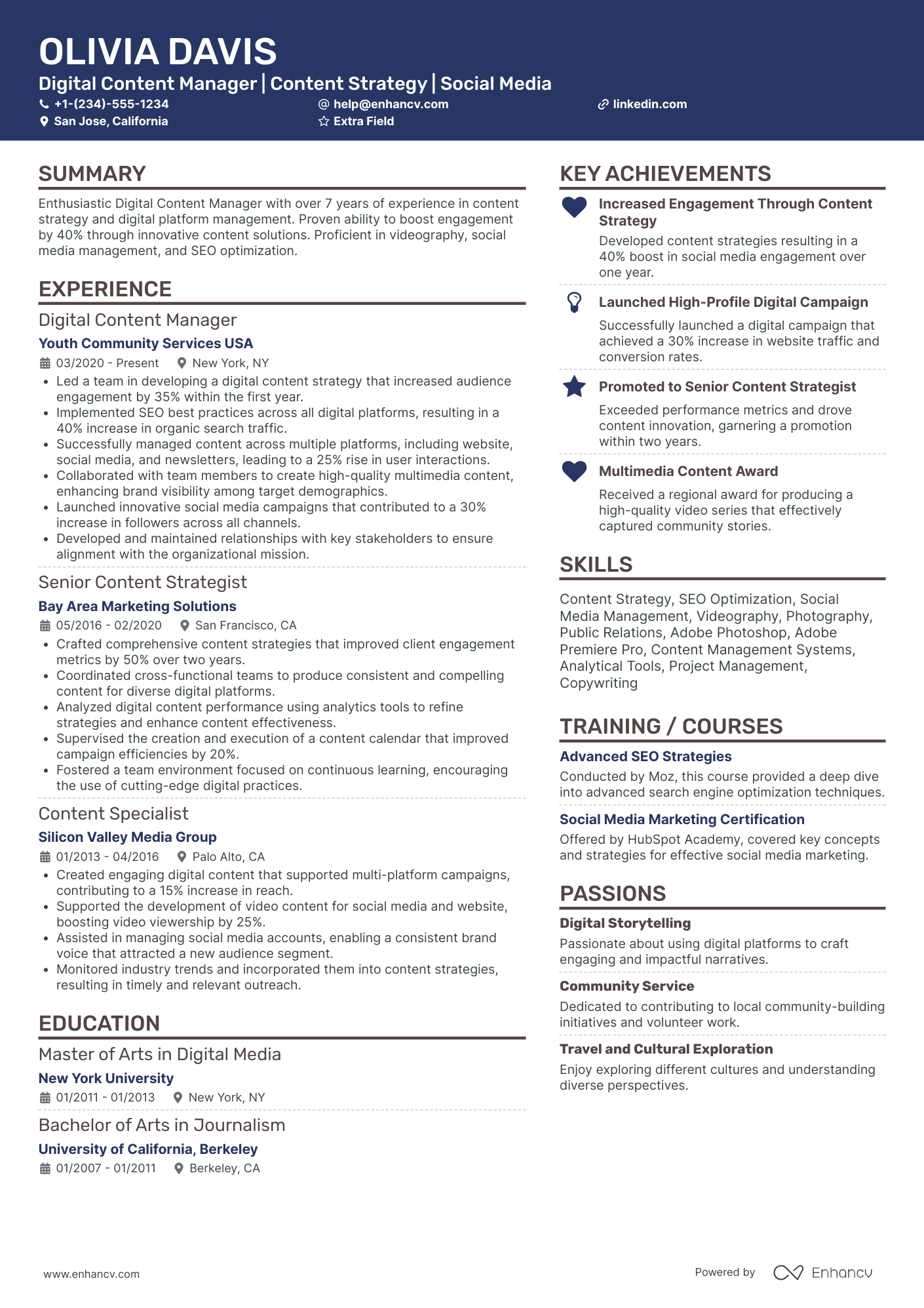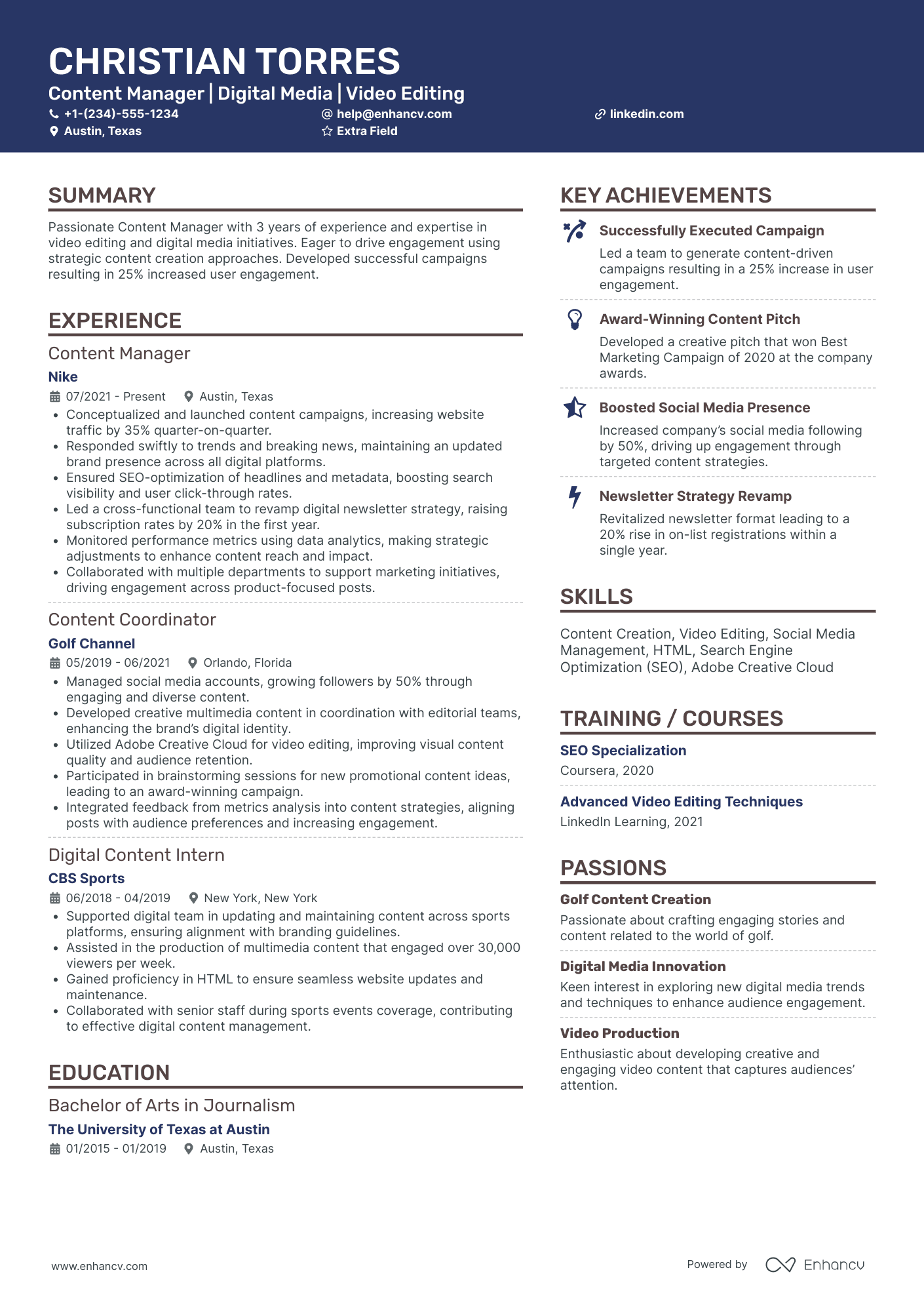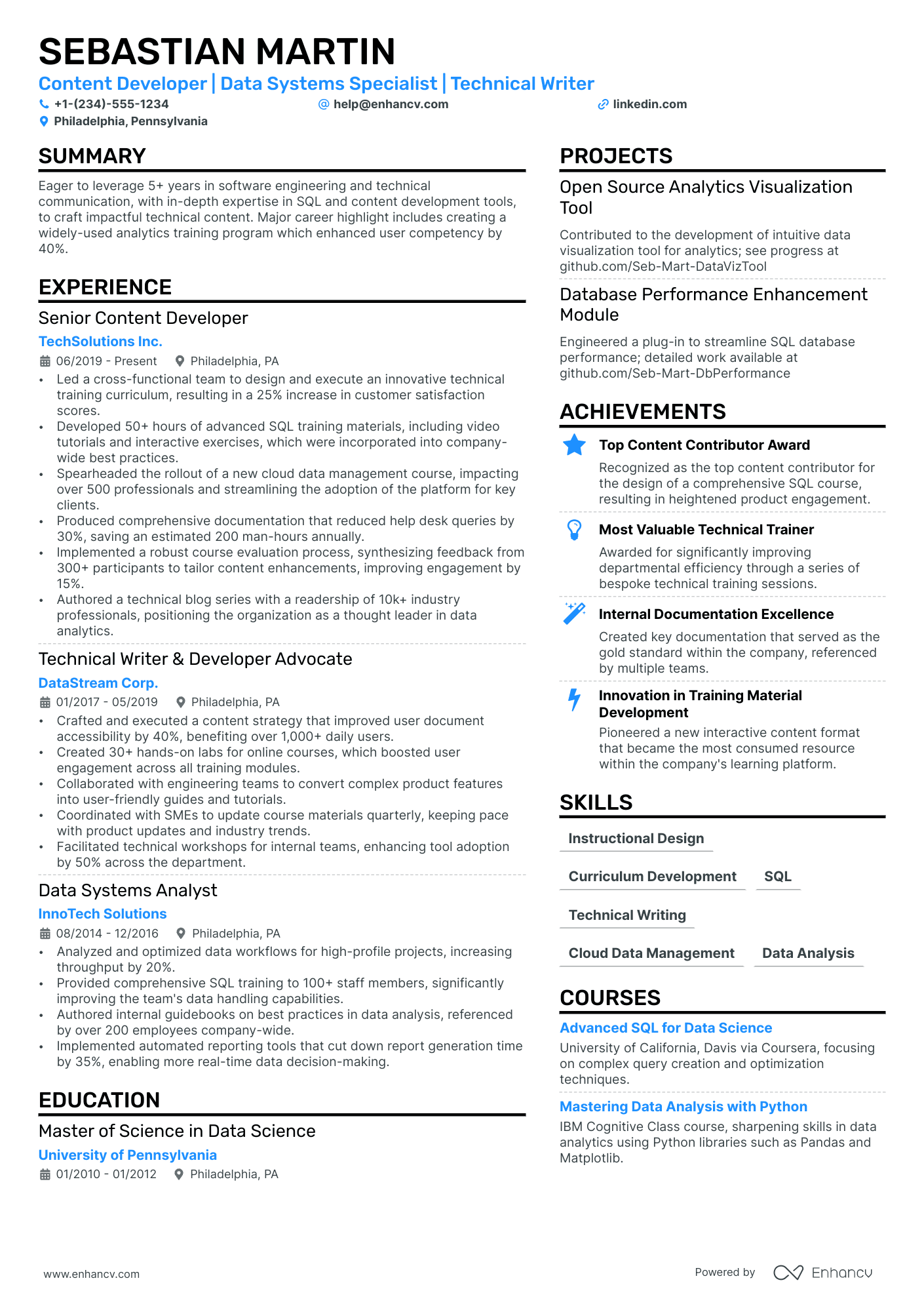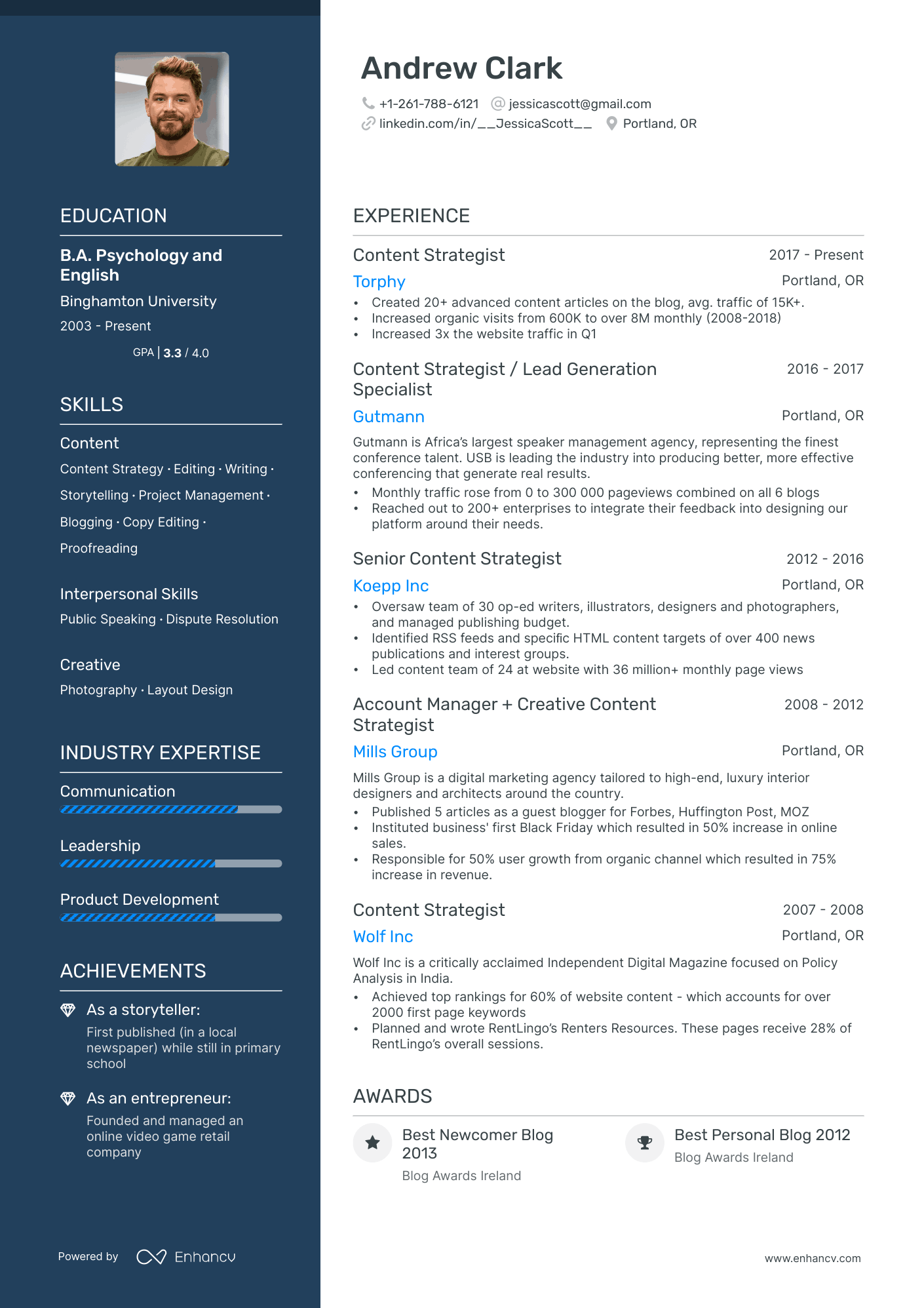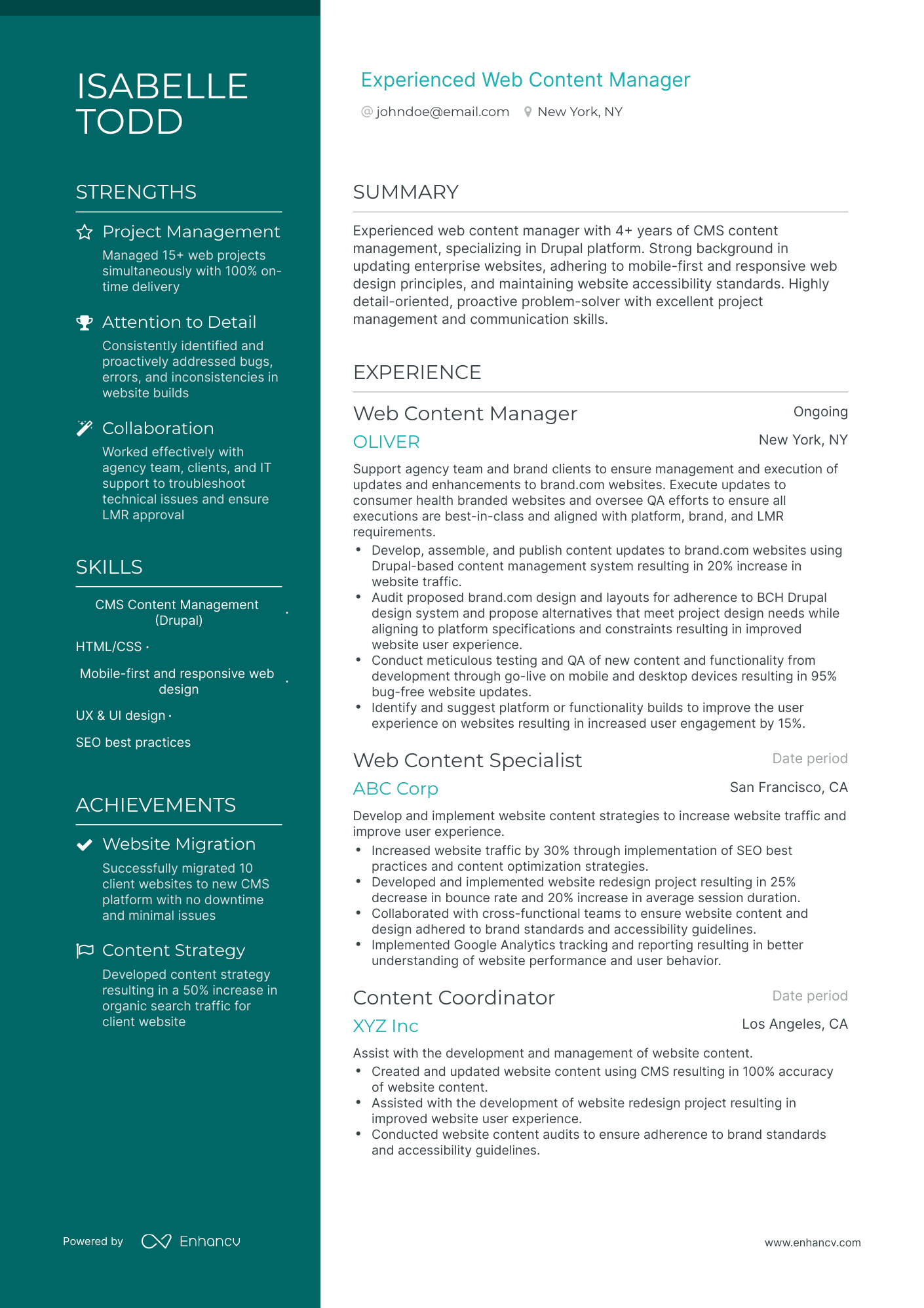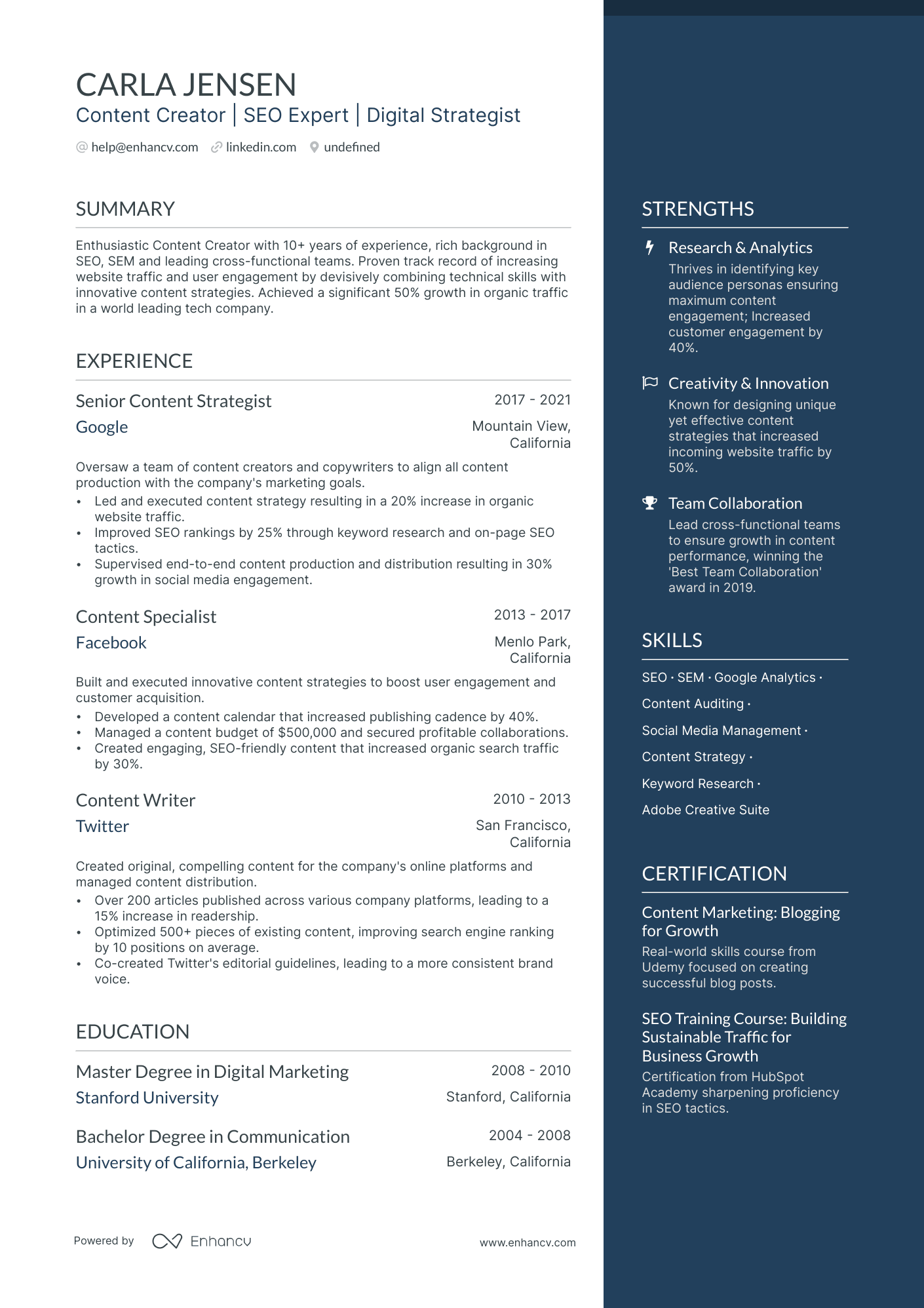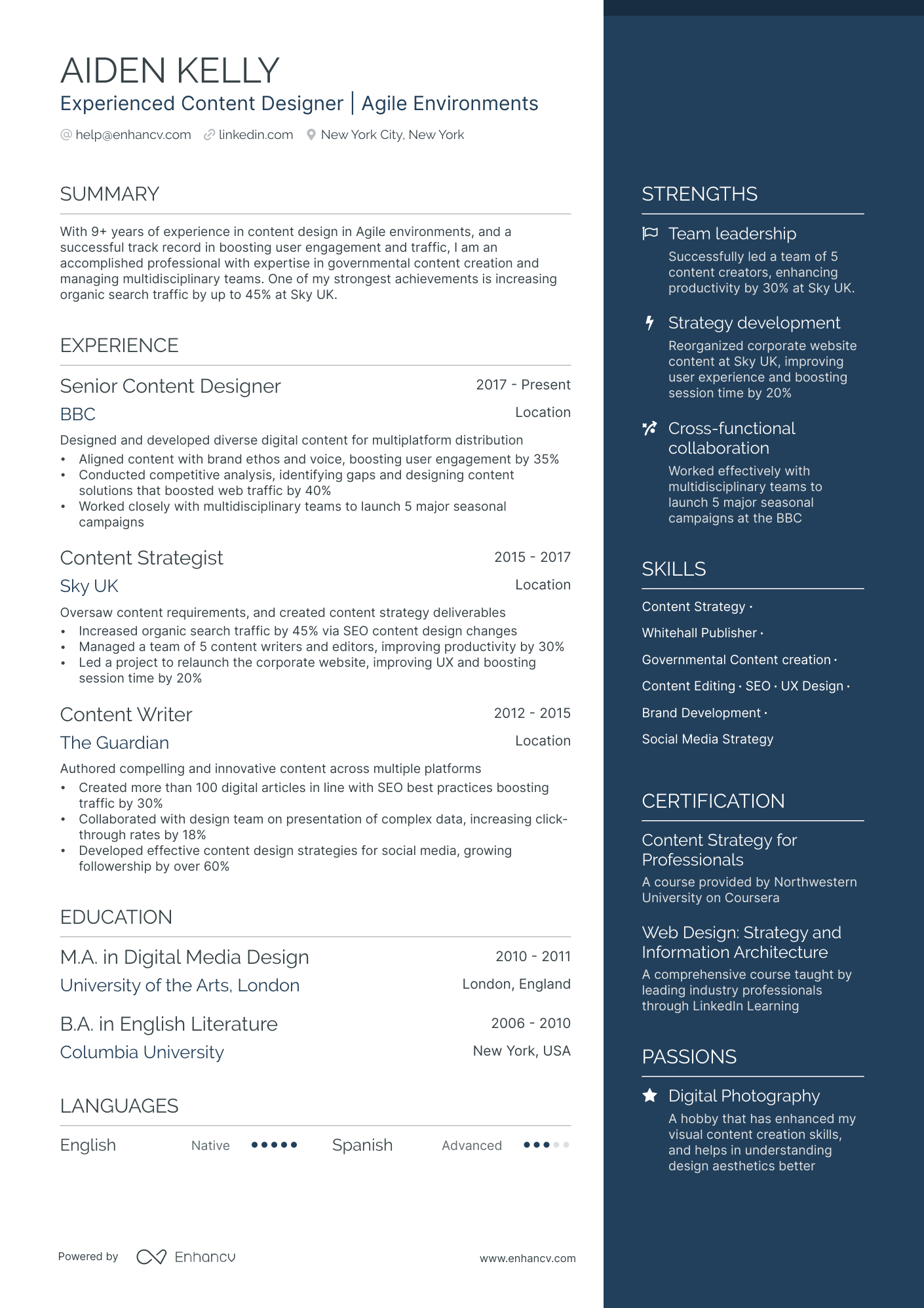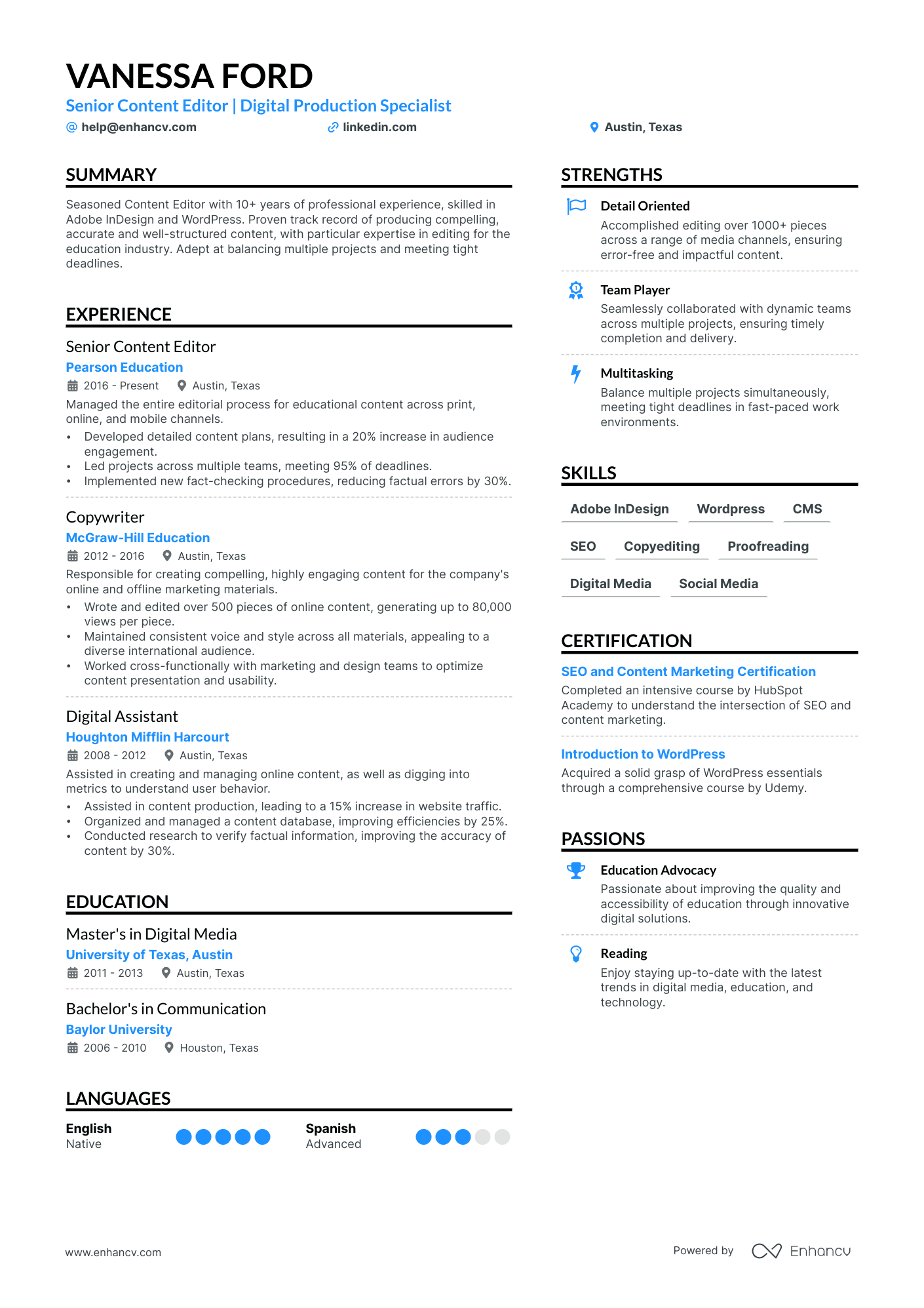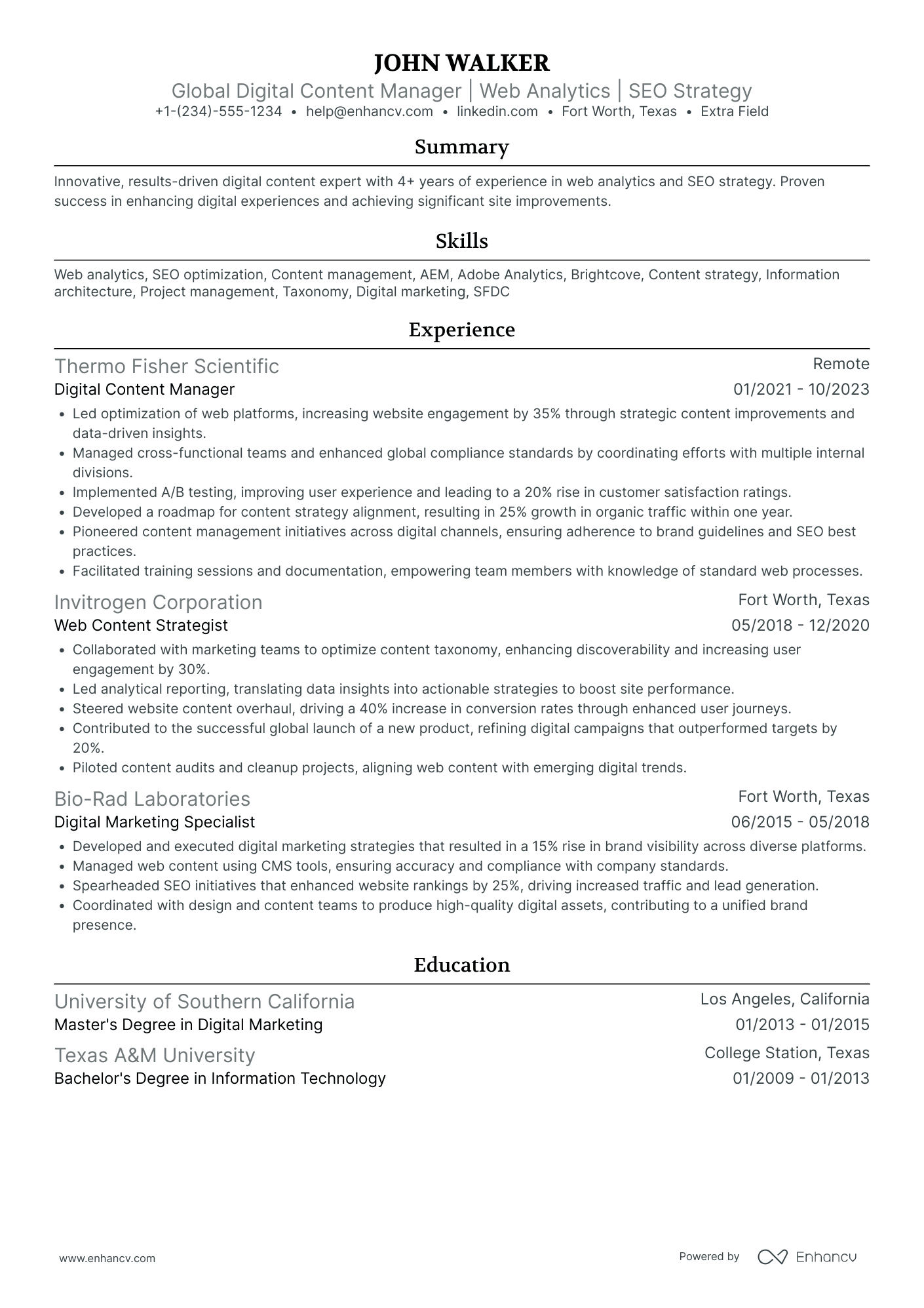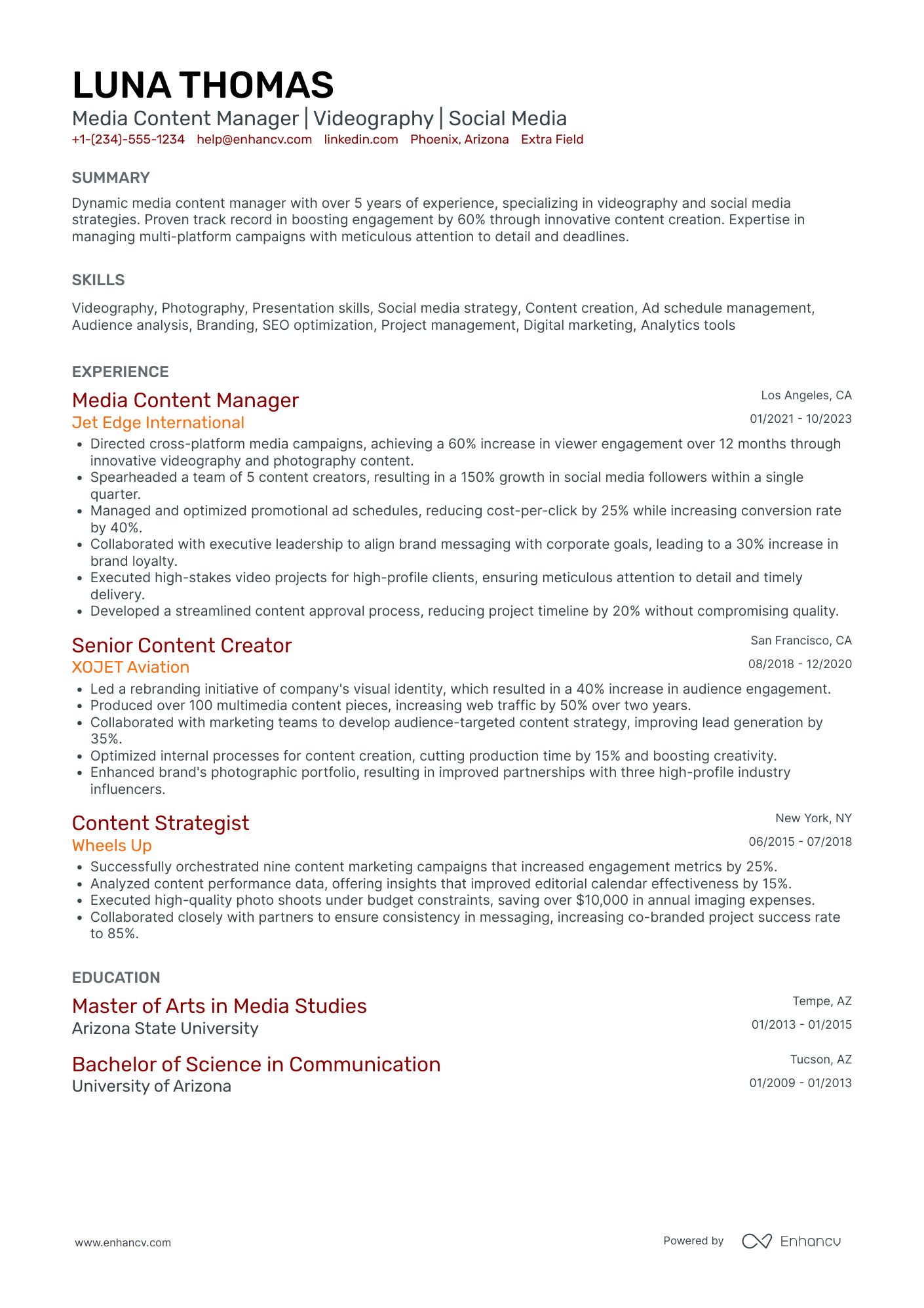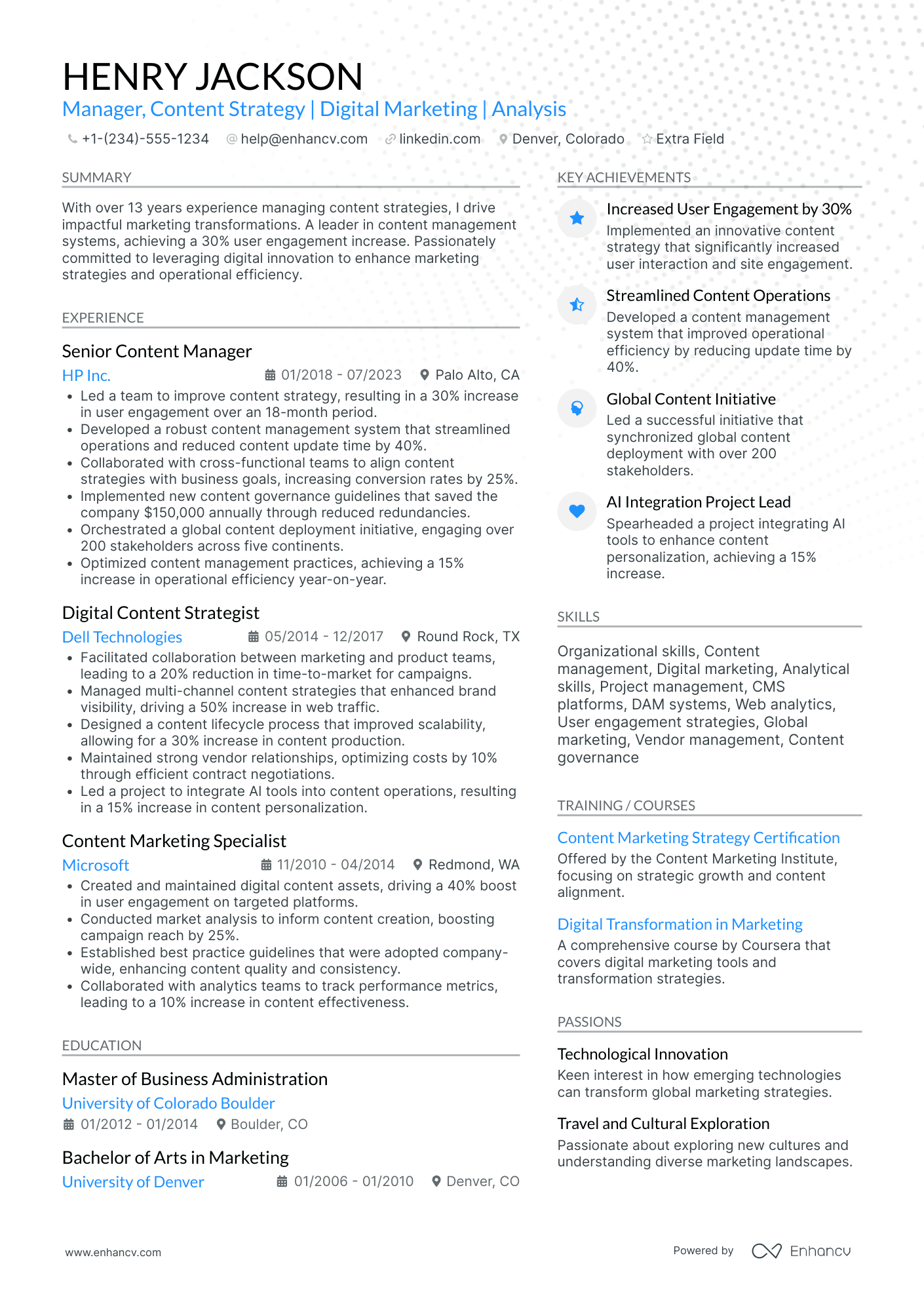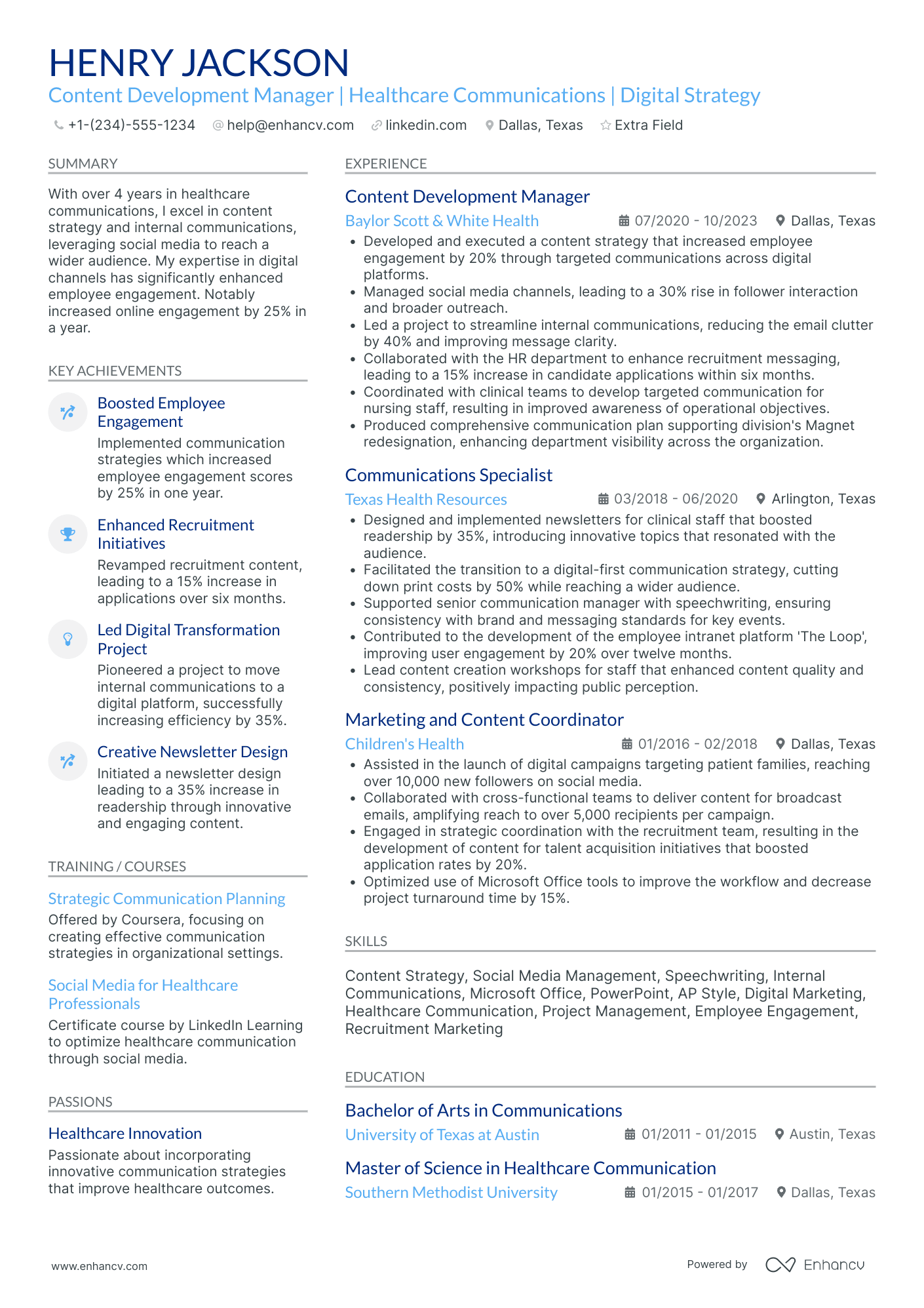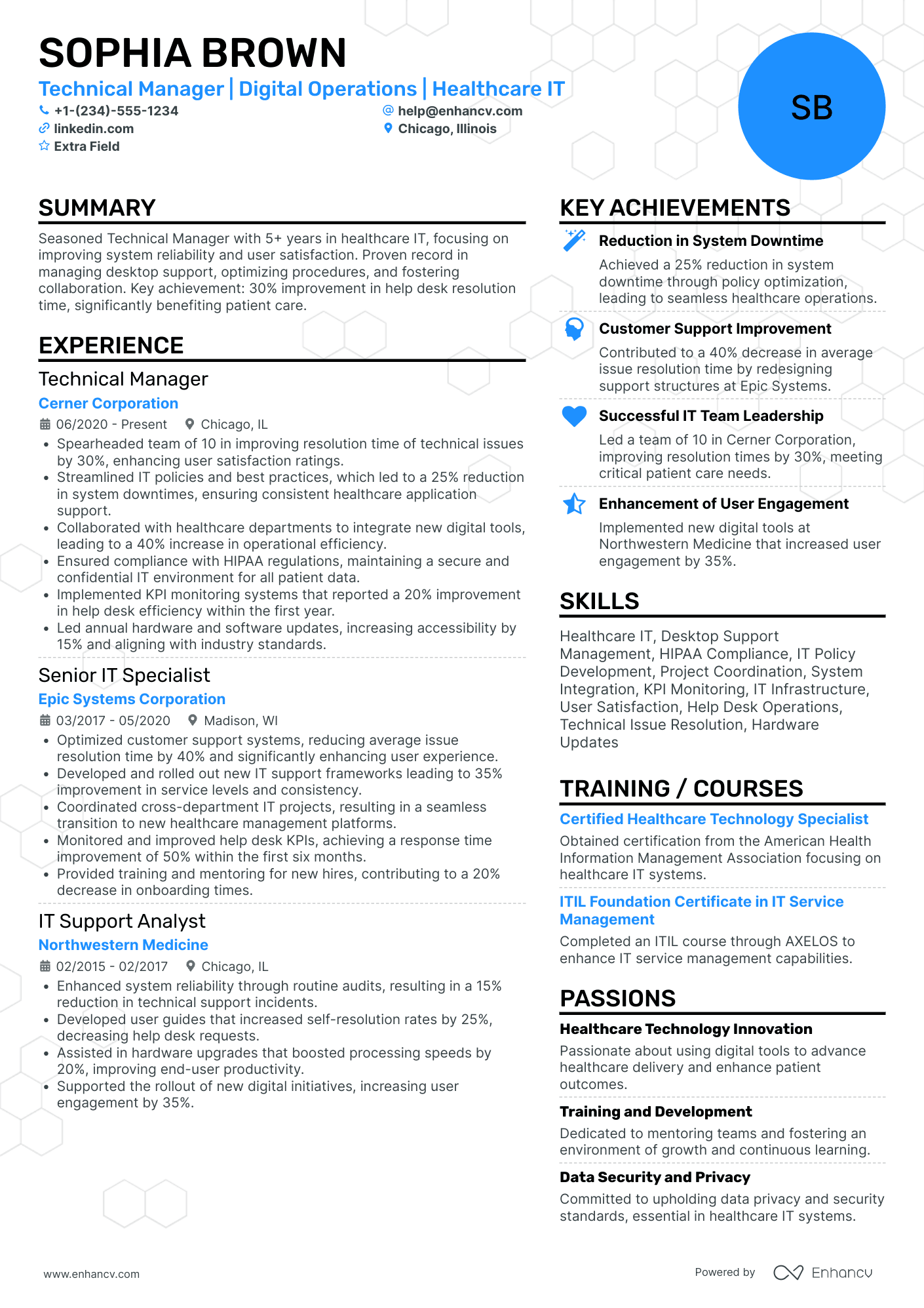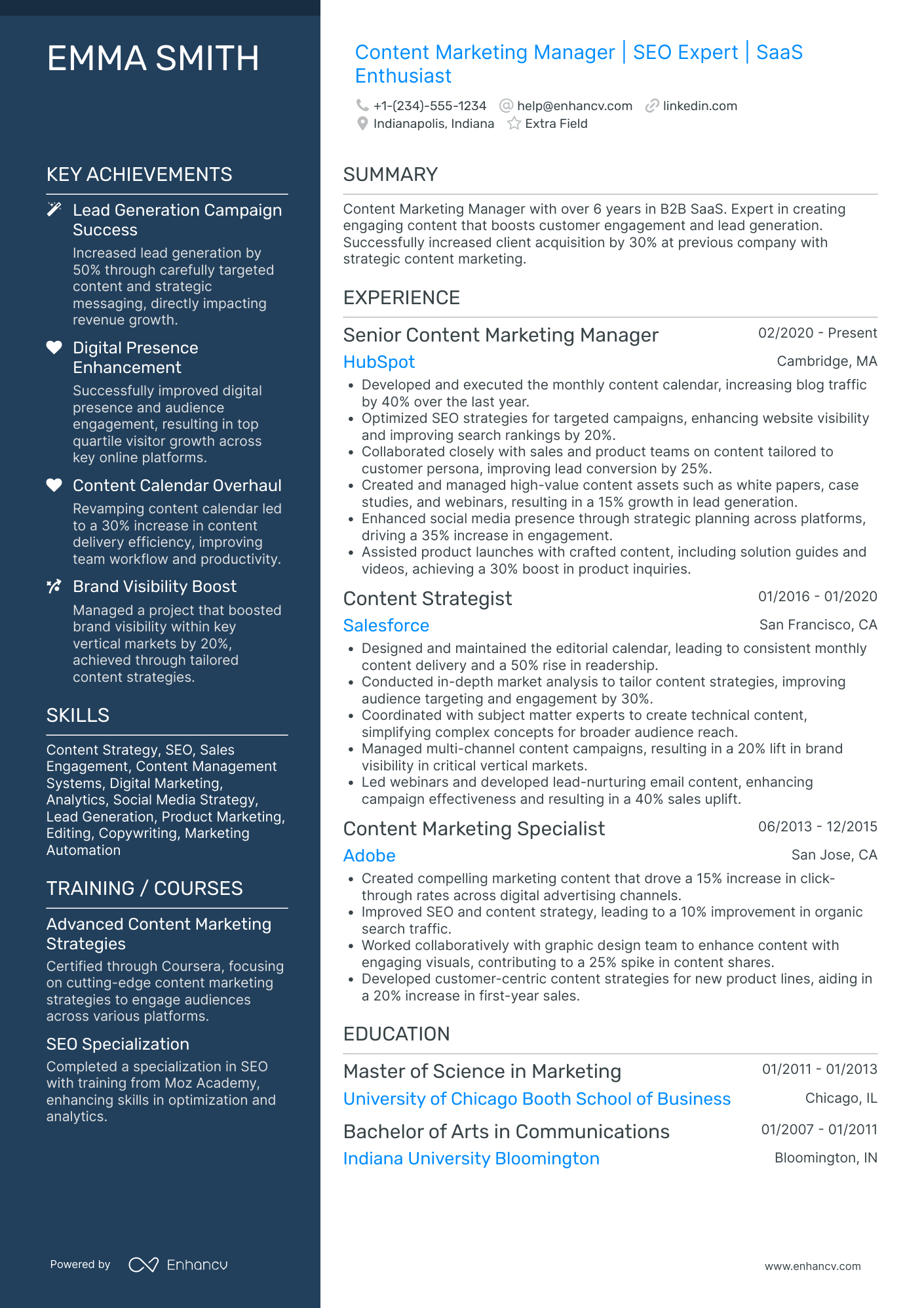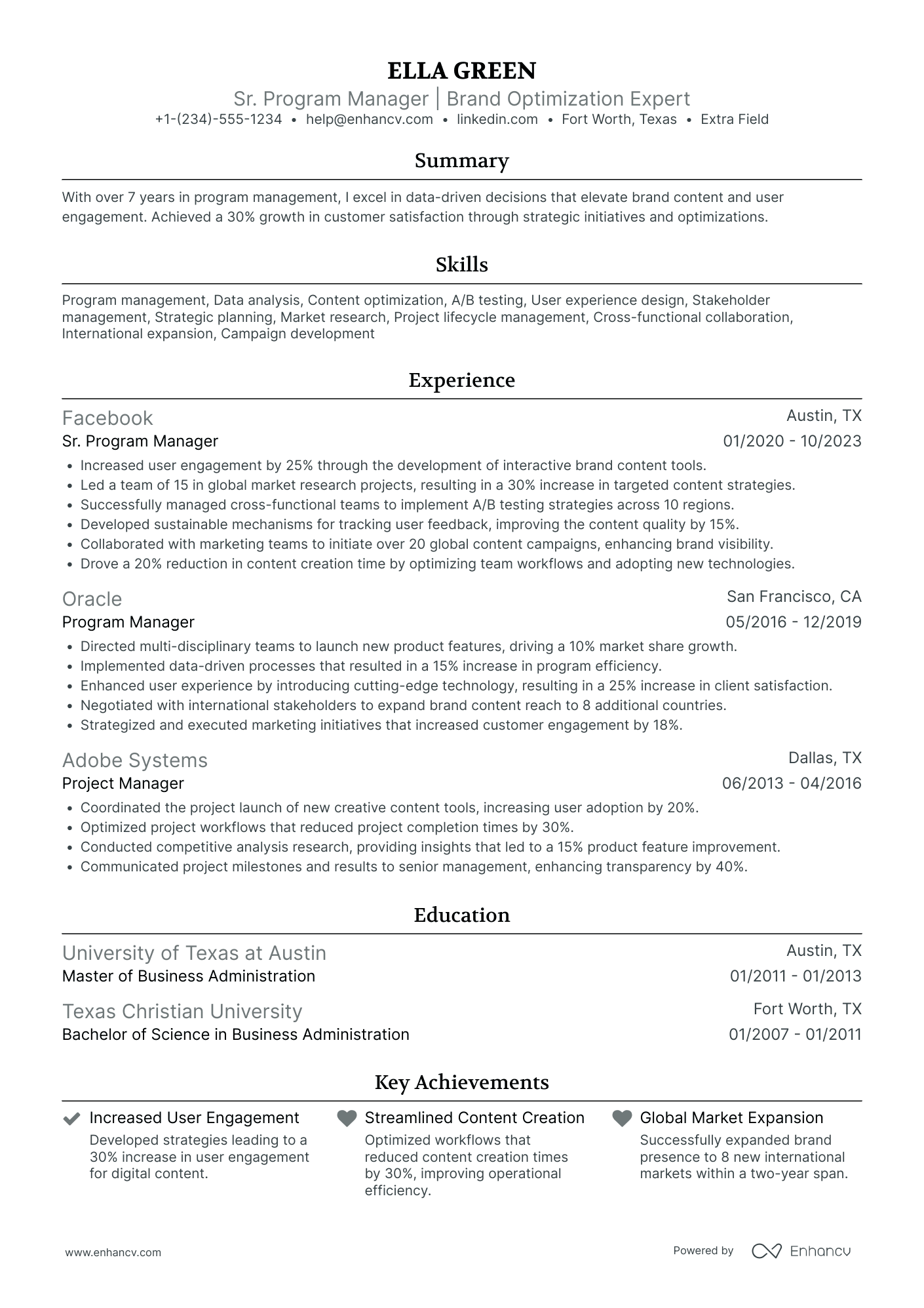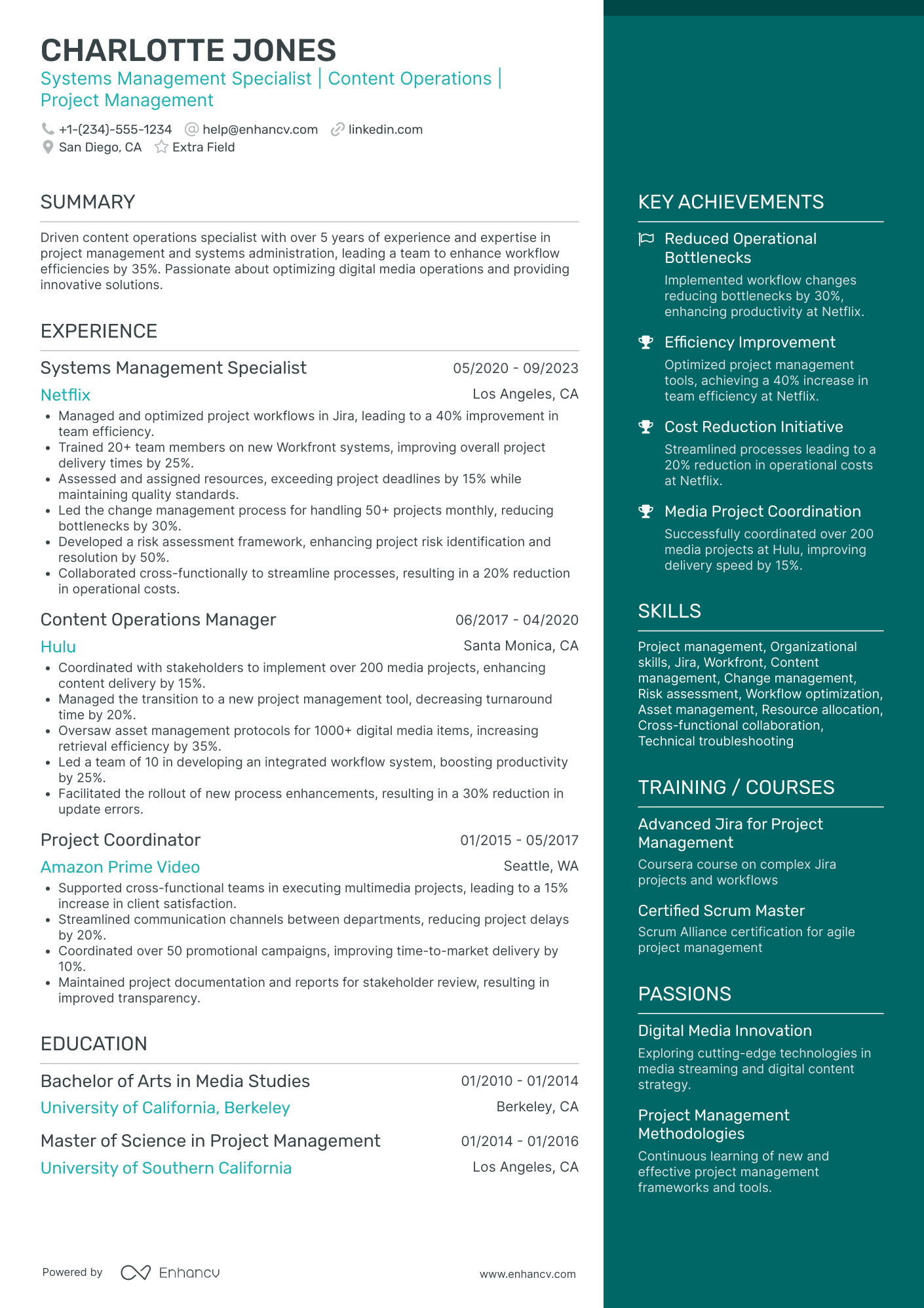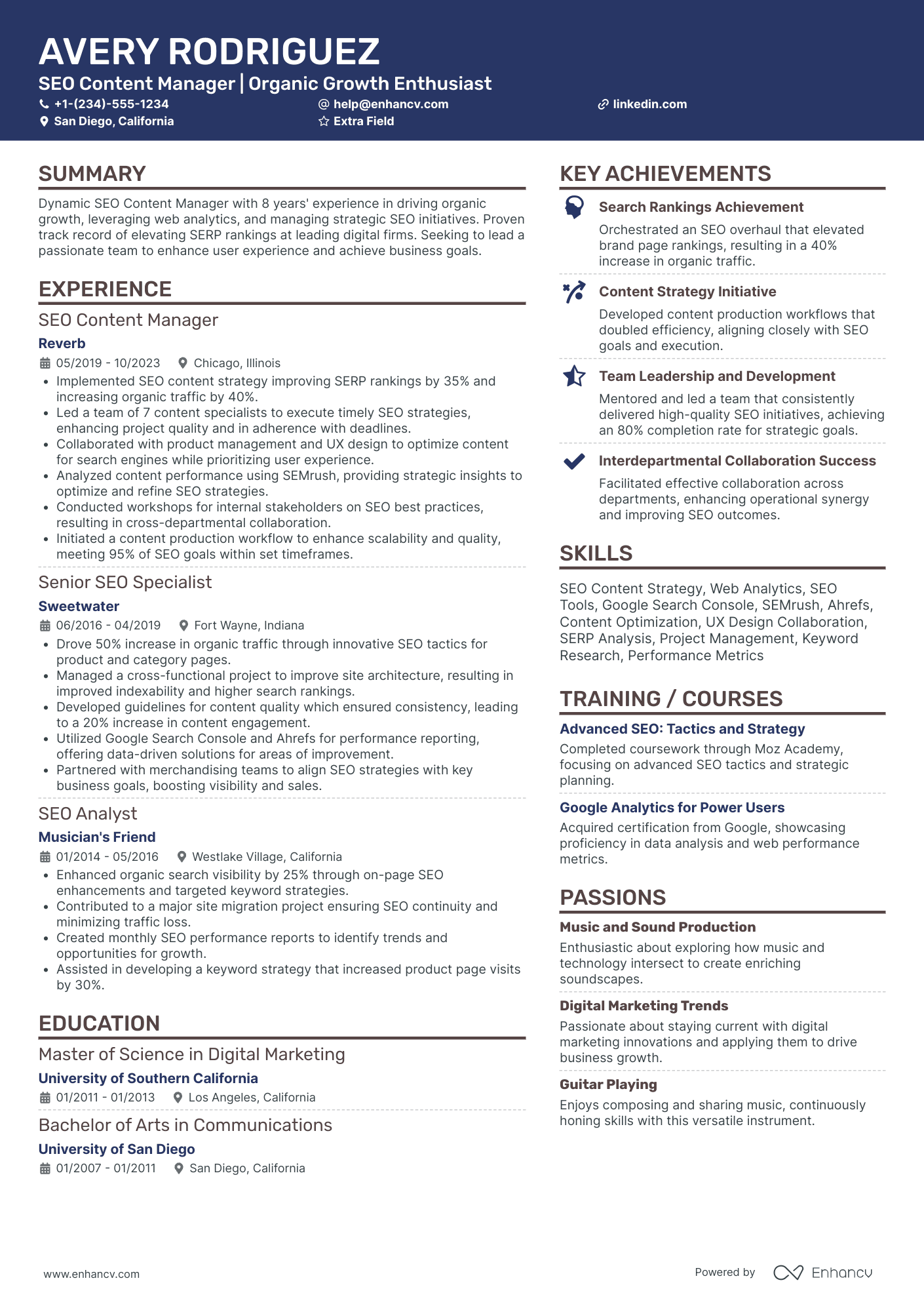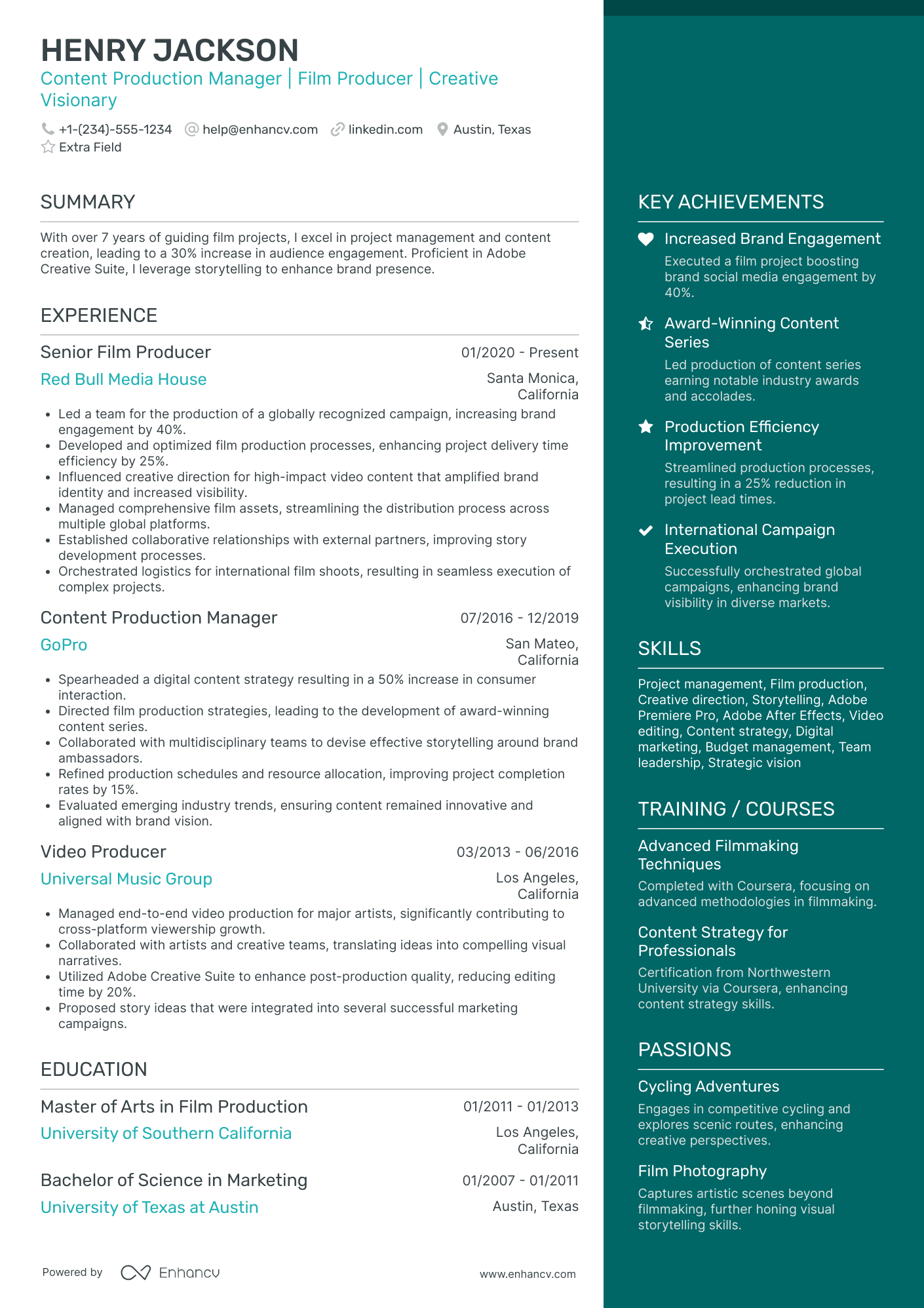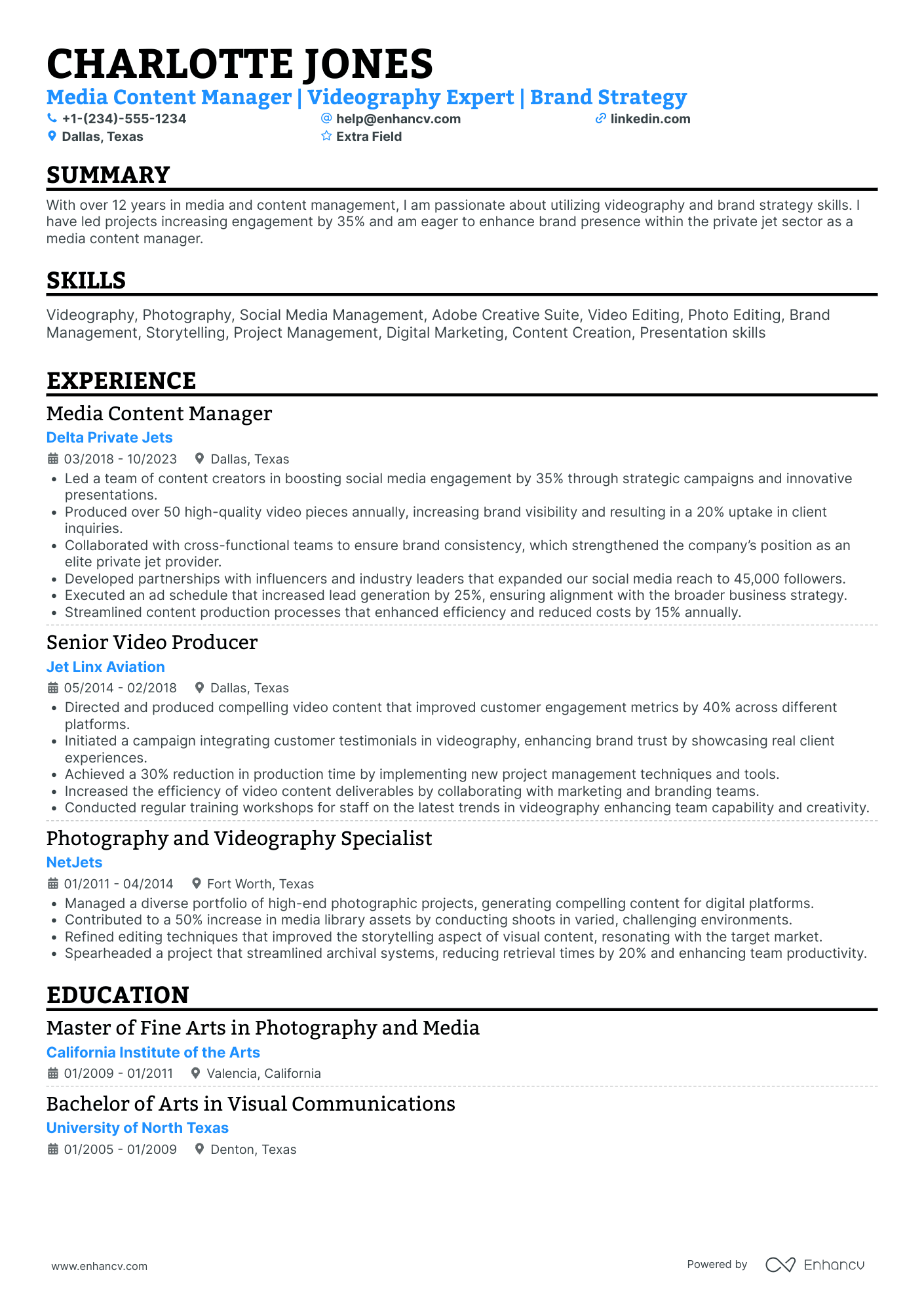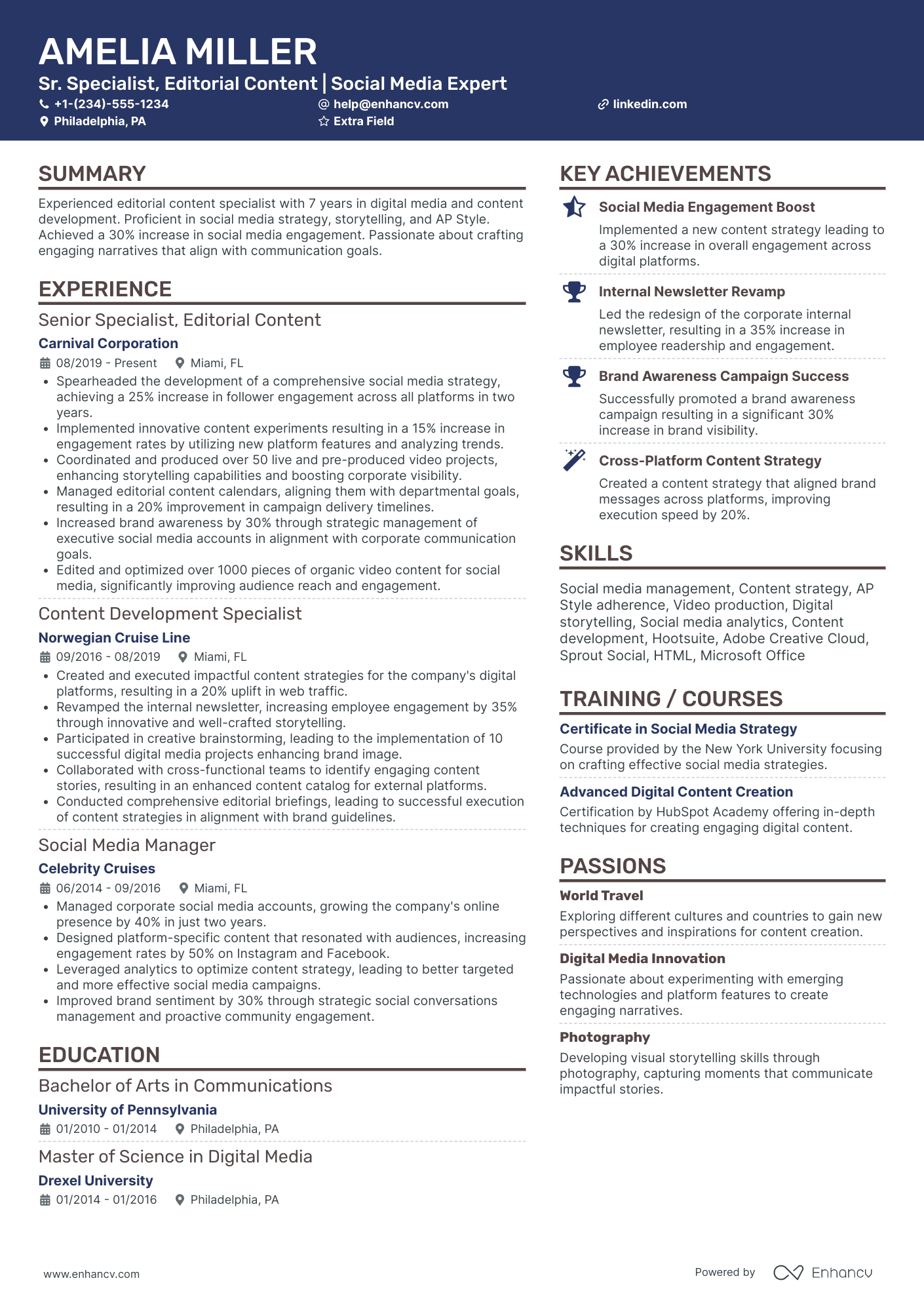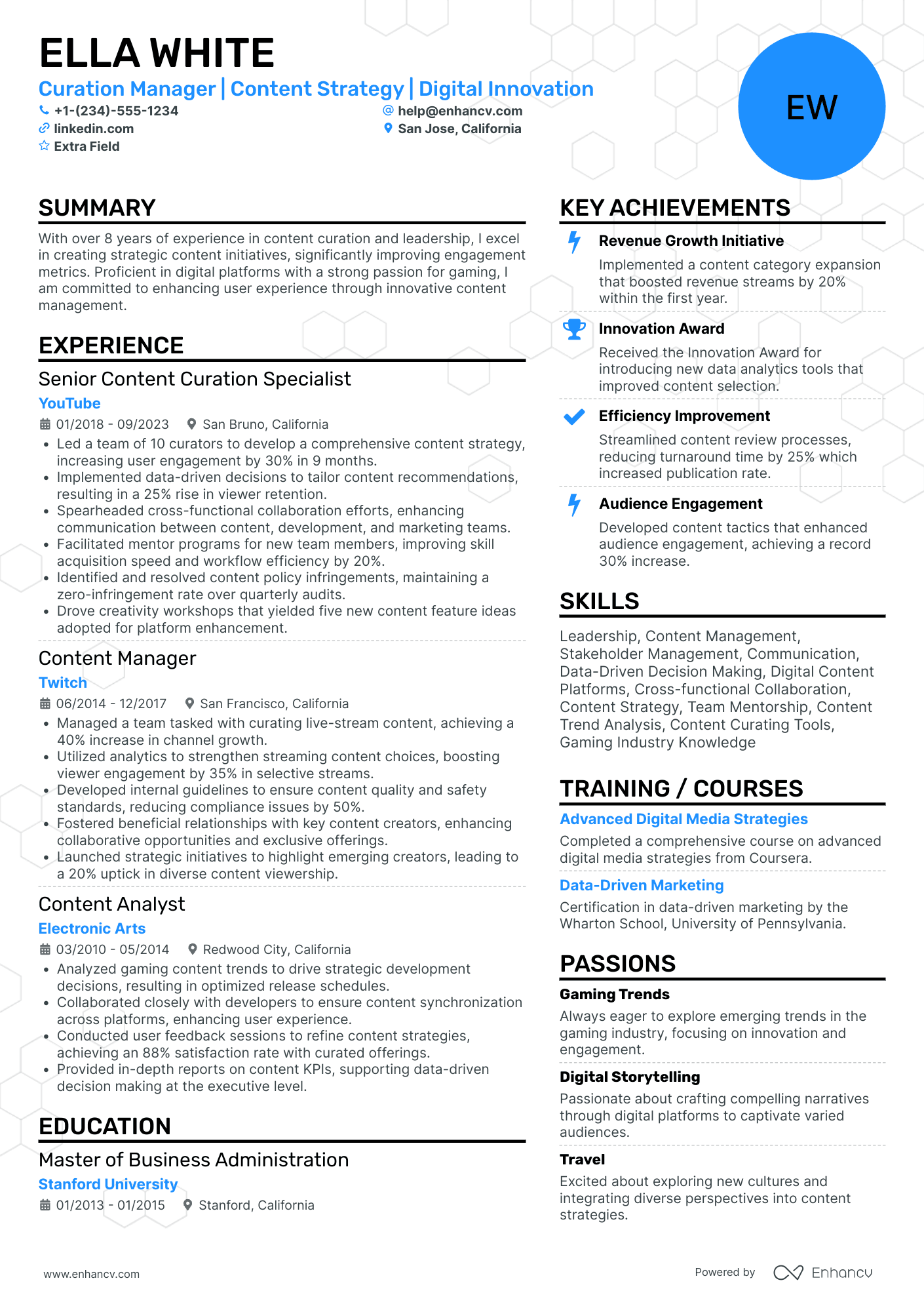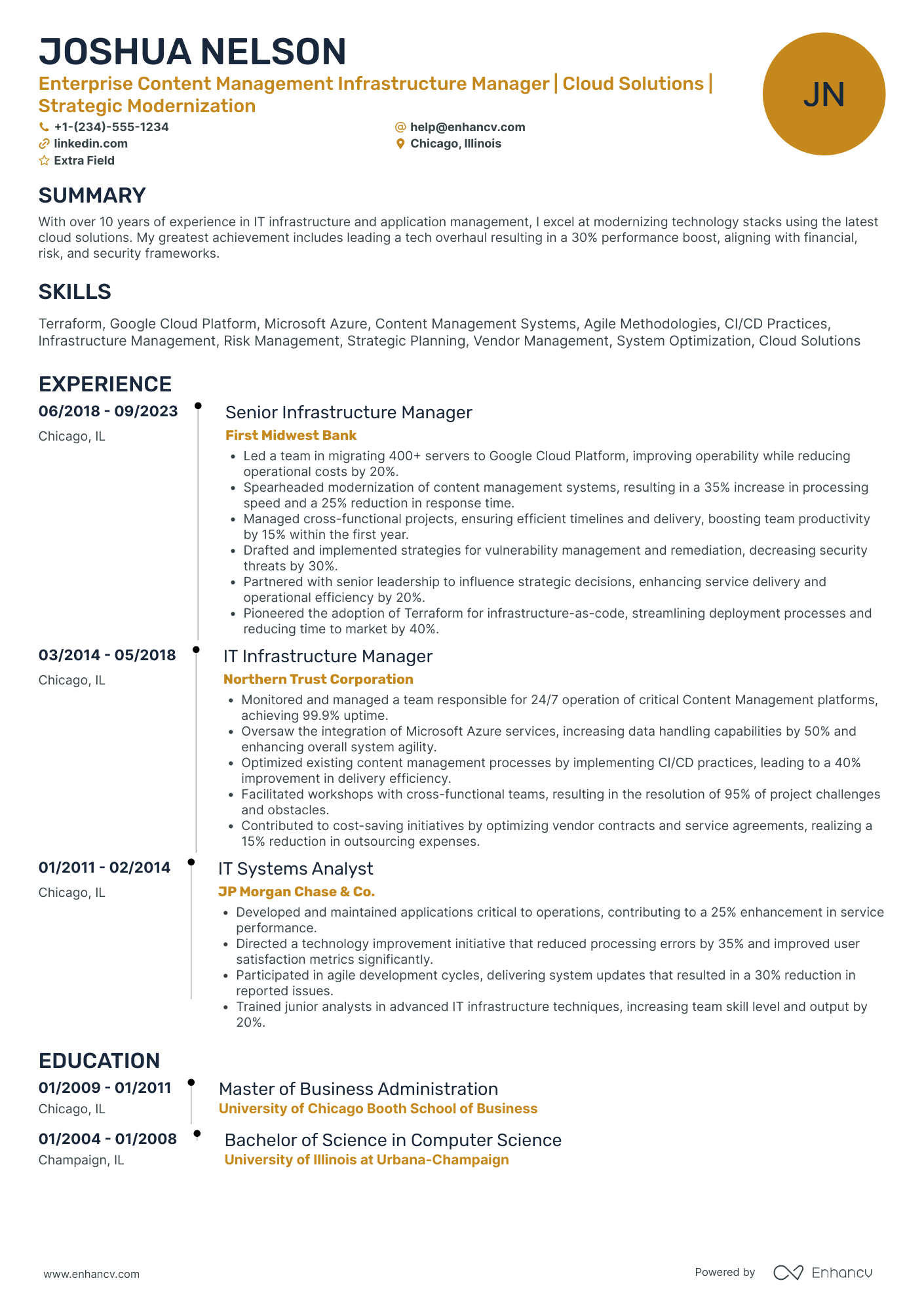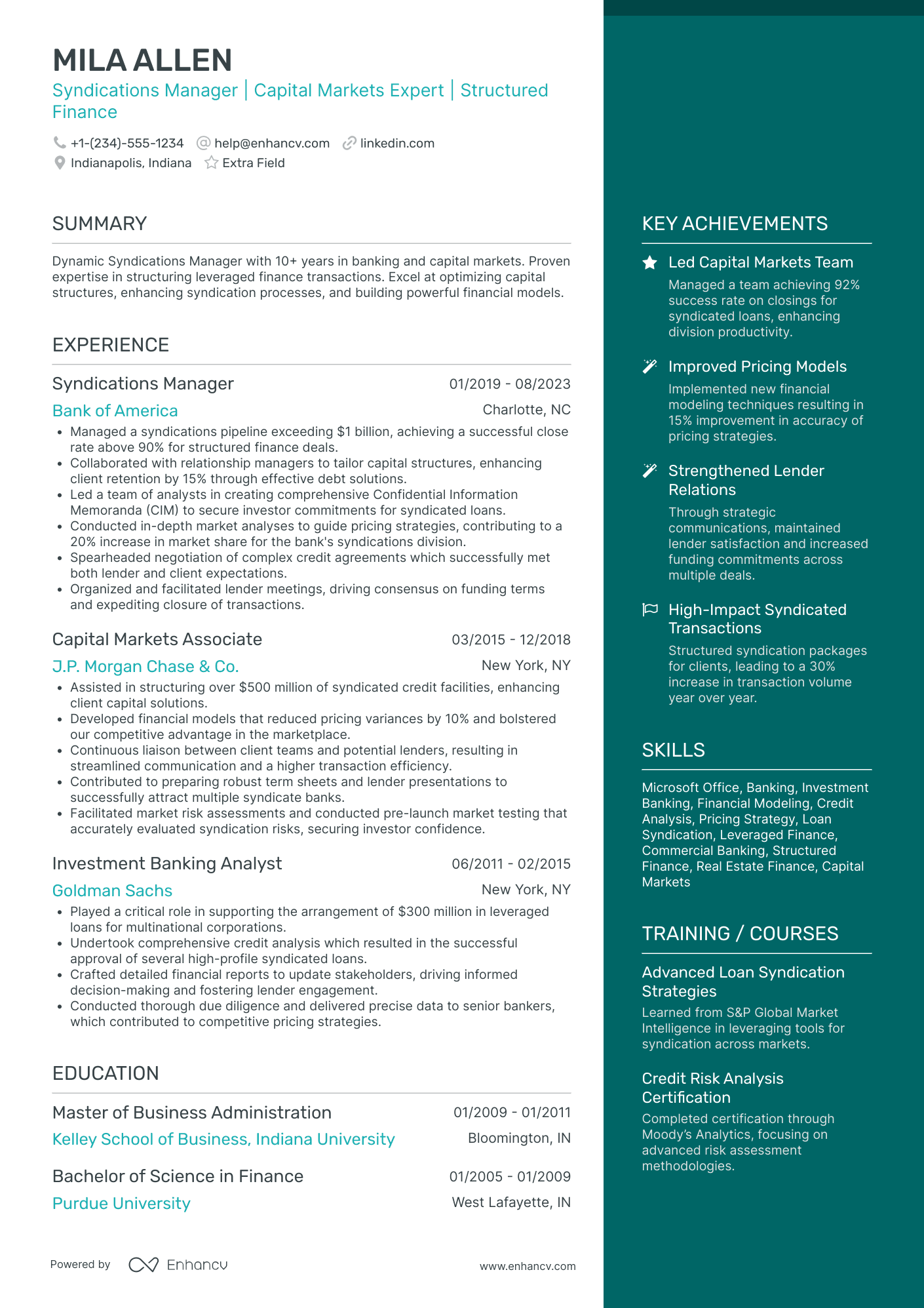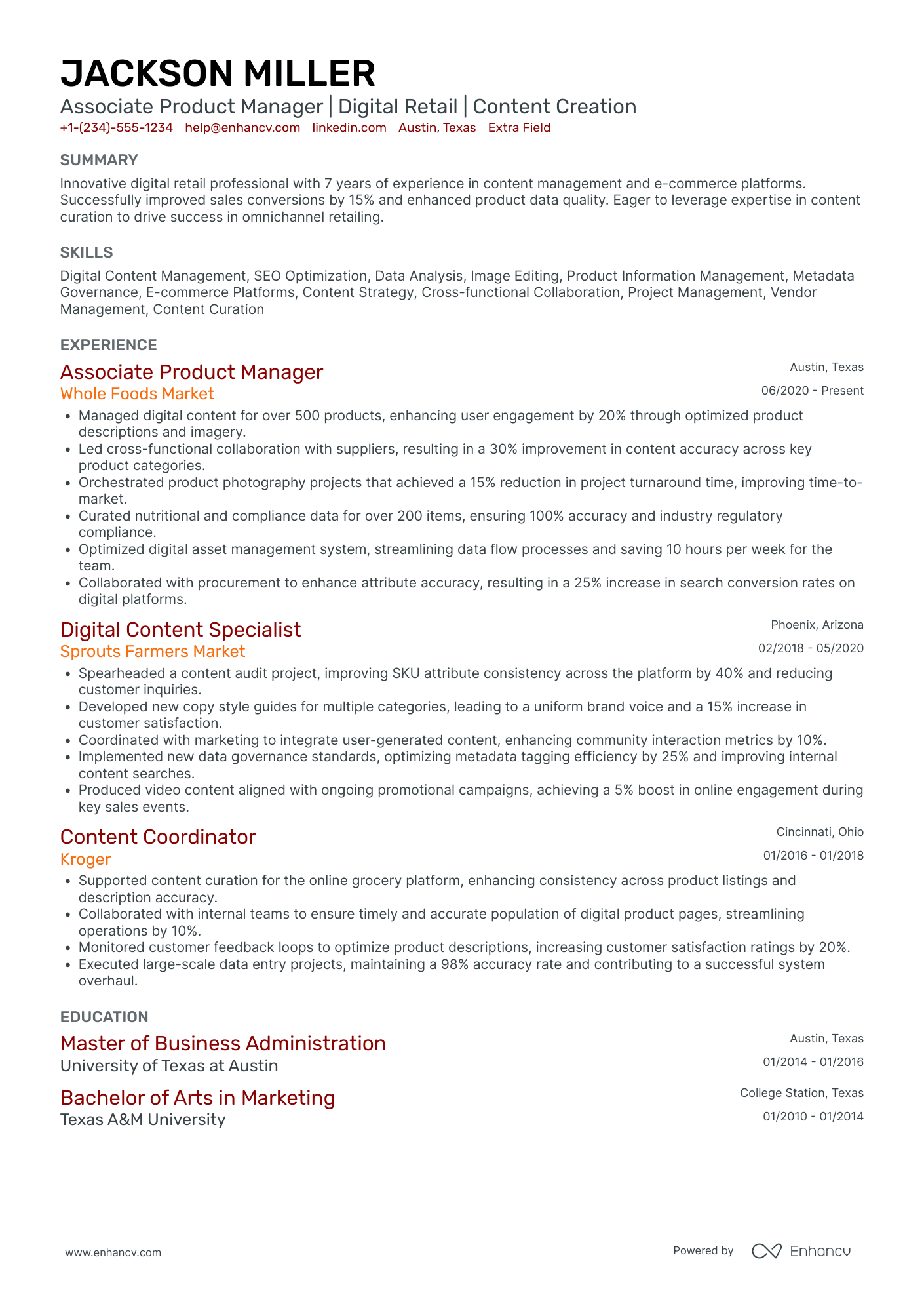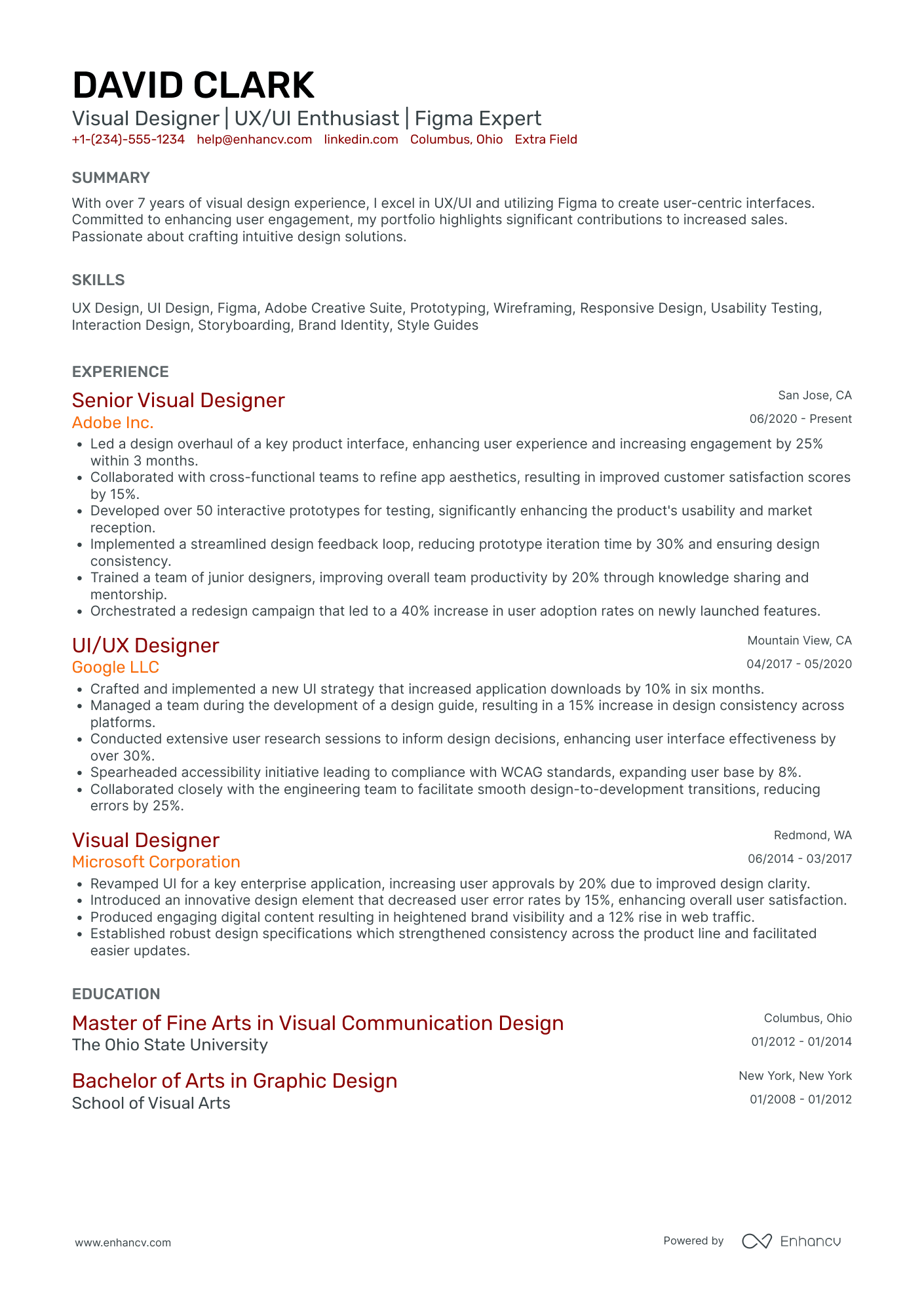A content manager's resume needs to do two things: show off technical prowess as well as their creative abilities. It’s a tightrope balancing act that can make building a resume for a content manager a bit tricky.
Don’t worry. This balancing act doesn’t require you to learn how to walk on a tightrope. Unless that’s a skill the job asks for.
We will go over all of the steps you need to create an attention-grabbing content manager resume that highlights how you helped the company foster its brand voice and recognition and increase website engagement.
As you read through this guide, we will cover how to format your data manager resume as well as how to:
- Quantify your past work that shows how your skills improved the company’s data structure and processes;
- Tailor your resume to include job-specific keywords and phrases;
- Highlight relatable skills that will score high with applicant tracking systems;
- Demonstrate advanced education by listing certifications and personal creative recognition and awards;
- Add links to social media accounts and a portfolio website to further showcase your skills.
We’ll also go over the best sites to find a new job and some specialized sections that are only available through Enhancv resume templates.
If the position of content manager is not quite right for your career ambitions, you’ll find additional resume examples for similar roles here:
Content Manager resume examples
By Experience
By Role
How to format a content manager resume
To give your resume a chance in the spotlight, you need to make sure it is properly formatted resume. Plus, it makes it easier for recruiters and hiring managers to read as they expect each resume to look a certain way.
The days of siphoning through every single resume to hand-pick a select few are over. Nowadays, companies use applicant tracking software for that monotonous task. This means if your resume does not meet industry standards, it may not pass the initial scan.
First off, if you are using Microsoft Word or another word-processing app or software, new documents will already have the standard document format, so you don’t need to worry about margins or font size.
Some key points to remember when formatting each section:
- When listing education and resume experience, use a reverse chronological format
- Make sure your contact information is current, and you use a professional name
- Include technical sections to highlight experience with content management systems and photo and video editing software
- Keep your resume between one and two pages
- Keep your font size between 10-12 points
If you choose an Enhancv resume template, all of the necessary sections are included as well as additional sections to highlight certain skills, strengths, and interests. They also have all of today’s popular fonts, like Rubik, Lato, Montserrat, Raleway, Exo 2, and Volkhov.
For those of you who prefer the classics, like Arial and Times New Roman, you can still use those. The more modern fonts are simply cleaner and give your resume a more polished look.
Whichever fonts you choose, go with a serif or sans serif type. Avoid those curly and artistic fonts, as that will get your resume a one-way ticket to the unacceptable folder.
Before we move on, let’s talk a little more about applicant tracking systems (ATS). They make the job of searching through hundreds of resumes for a single position a piece of cake.
Recruiters enter the job description with job-related keywords, like content strategies, search engine optimization, and brand management. The software searches through each resume for these keywords and scores them based on how many it finds.
This is why it’s important to match your skills word for word for each job you apply for. You will score higher points if the job description and your related skills match exactly.
Before sending out your resume, save a copy as a PDF type (.pdf). This ensures your resume will keep its formatting and is accessible on all computer systems.
Different markets have specific resume styles – a Canadian resume, for instance, may require a different approach.
Let’s see how your current content manager resume stacks up to today’s standards. Use our resume checker to see how well your resume does compared to real-world examples.
The top sections on a content manager resume:
- Header: Include your first and last name, job title, phone, email, professional social media account, and website portfolio link.
- Summary/Objective: This section gives a 2-3 sentence description that either summarizes your career and goals or describes your objective in building a career as a content manager.
- Resume Experience: Here, you will list any full-time, contract, and freelance work that relates to the job.
- Education: Include all post-secondary education along with any Master’s or Ph.D. and industry-related certifications.
- Hard and soft skills: In these sections, you will list your technical skills (hard skills) and personal skills like creativity and leadership skills.
What recruiters want to see on your resume:
- Proficiency with content management tools, such as WordPress, Drupal, and Joomla
- Demonstrate professional copyediting and creative writing skills with links to published blog content and viral posts
- A firm understanding of the digital marketing landscape and knowledge of social media marketing, email marketing, and online advertising
- Experience with photography and videography equipment, photo and video editing software, basic HTML/CSS, and software like Adobe Creative Suites and Google Analytics to showcase technical proficiencies
- Membership in any professional associations or local networking groups to demonstrate they are staying up to date with industry trends and new technologies
Time to dive into adding your relevant work experience. Later on, we’ll go over how to add relatable jobs and personal projects for content managers with no experience.
How to write your content manager resume experience
Your resume experience section will contain all relatable work experience, whether it be with a company or as a freelance content creator. What you don’t want to list here is personal creative projects.
Content managers need to wear many different and sometimes colorful hats, and this can present a unique challenge for adding relevant work experience. One common mistake people make when adding previous jobs is they simply list the job duties and forget to include how their work benefited the company or project.
Let’s take a look at a real-world content manager resume experience example so you can see for yourself:
- •Develop content for real estate website in Rehoboth, DE, and surrounding areas
- •Manage the development and implementation of blog content to increase traffic
- •Collaborate with multiple teams to develop new content
- •Analyze web traffic to identify new trends, improve content performance, and SEO optimization
- •Implement audits to ensure brand consistency
This example is pretty lackluster and fails to show how they improved the company's brand recognition and content.
Do you get a feel for how this reads more like a job description than resume experience? If you were hiring a content manager, would you want to speak with this person? Probably not, especially after reading the next example.
When adding relevant work experience, you want to use action verbs. “Analyzed” instead of “analyze”, “implemented” instead of “implement”, and so on.
One more thing to notice here. They have the location within the job details. This information goes underneath the company name and industry type. Adding it to the bullet list just wastes precious space.
Now let’s take a look at the same example that does a better job of listing specific details:
- •Developed a new content strategy plan for real estate website that resulted in a 20% increase in organic traffic
- •Managed the development and implementation of successful blog campaigns that attracted over 10,000 monthly readers
- •Collaborated with 4 creative teams to develop engaging content that includes photos, videos, infographics, animations, and interactive apps and webpages
- •Developed and managed 6 social media campaigns to reach new audiences and increase brand awareness
- •Analyzed website traffic data to identify new real estate trends, improve content performance, and optimize SEO rankings
- •Implemented new content audits to review and improve existing content and ensure consistency of brand across all channels
See how much better that is? This example is what recruiters get excited over and will get you an interview.
This resume experience example does an excellent job of:
- Using numbers to quantify the impact of their performance with: “a 20% increase in organic traffic.”
- Lists the industry type and location in the correct order: Job title, company name, company description, location
- Includes industry-related keywords: optimize SEO ranking, social media campaign, and brand awareness
- Demonstrates leadership skills: “Collaborated with 4 creative teams… 6 social media campaigns”
Notice how this example lists experience with creative software and hardware. This is an easy way to indicate creative abilities without using too much space.
You’ll be able to show off your creations and collaborations through a portfolio link, which we will discuss later.
Before we get into how to add resume experience for content managers with no real-world experience, we need to focus on using numbers and percentages so you can quantify your experience.
How to quantify the impact on your resume
A successful content manager will have a mix of creative skills and a mind for business. They can analyze data and design a creative solution for increasing web traffic at the drop of a hat.
How can you show the results of all of your hard work that happens behind the scenes? By adding numbers and percentages to quantify the impact of your work.
Here are some examples of how to do this:
- Increase in web traffic – “Developed content marketing strategies across all websites, which led to an increase in monthly website traffic by 40%.”
- Growth in social media engagement – “Managed 3 social media accounts and oversaw the development of new content that increased engagement rates by 25%, which led to a 15% increase in social media followers across all accounts within 6 months.”
- Improvement in SEO rankings – “Wrote and edited SEO-optimized content based on trending topics that led to a 30% increase in organic search rankings through the use of industry-related keywords and phrases.”
- Content conversion rates – “Utilized web analytics to analyze and track the success of content campaigns, resulting in a 15% increase in website conversion rates.”
- Reduction in bounce rates – “Created new daily content to increase brand awareness through blog posts, product and service description, and social media content using trending keywords and content that reduced bounce rates by 30%.”
- Increased content production and efficiency – “Audited content management systems to identify areas of improvement and streamlined all content creation processes, which decreased production time by 20% without adding additional content creators.”
- Revenue growth – “Developed new content strategies across all platforms that increased user engagement and attracted new followers that led to a 10% increase in revenue growth.”
- Increases in user engagement – “Designed more user-friendly apps and landing pages based on customer reviews that improved user experience and increased engagement by 35%.”
When writing down numbers in a resume, a spelling and grammar checker may suggest you write out the number instead, such as four instead of 4. The official grammar rule for using numbers is to use the digit for single-digit numbers and write out larger numbers.
For your resume, stick with the numbers. That’s what ATS and recruiters want to see.
How do I write a content manager resume with no experience
If you are in the market for your first content manager position but worry about which past work experience to focus on, this section is for you.
A content manager resume with no experience can still land you that dream job despite lacking real-world manager experience.
To qualify for a content manager position, employers generally like their managers to have 5-10 years of professional experience creating content strategies, increasing brand awareness, and producing original content.
If you have experience as an editorial assistant, copywriter, web content coordinator, or content creator, you can use that experience on your content manager resume.
When adding relevant work experience, you want to keep in mind the following:
- Include paid and unpaid projects that highlight relatable skills
- List any experience where you demonstrated leadership or problem-solving skills
- Detail all content creation experience, including blog posts, articles, photo montages, and video clips
- Highlight any special recognition, awards, or advancements
Here is an example of how the resume experience section of a resume for a content manager with no experience will look like
- •Wrote and edited feature articles and restaurant reviews resulting in a 10% increase in magazine subscriptions
- •Developed and executed social media campaigns resulting in a 25% increase in web traffic
- •Assisted managers in supervising and organizing 2 teams of freelance writers and content creators resulting in a 15% improvement in content quality
- •Received recognition for outstanding performance during new channel launch that resulted in a 10% increase in pay and a $5000 bonus
While there may have been a lot more job duties for this position, it’s not necessary to list them all. Only include those details that show you have experience in the required areas in the job description.
Tailor your resume experience to the specific job you are applying for. A targeted resume will increase your chances of standing out from the hundreds of other content manager resumes recruiters have to go through to fill one position.
A content manager for Phizer will need a unique skill set and strategy type compared to one for Ben & Jerry’s Ice Cream.
The next few sections will cover those all-important hard and soft skills as well as additional skills that will help your resume demonstrate your knowledge and experience.
How to list your hard skills and soft skills on your resume
To demonstrate your abilities to create imaginative content and inspire teams to meet strict deadlines, you need several hard and soft skills.
Hard skills include technical skills you pick up through a college degree, internships, freelancing, and professional experience. It is where you pick up essential skills like SEO optimization, color analysis, photo and video editing, and building websites and user-friendly apps.
Your soft skills are those natural skills like thinking outside of the box, being adaptable, and emotional intelligence. You learn these skills through everyday interactions and your likes and interests.
The skills section of your resume is where you will include your hard and soft skills and other relatable skills. This can include skills such as speaking multiple languages and experience with various photography and videography cameras and editing software.
Take a look at these real-world examples of skills sections for a content manager.
Here are some of the common hard and soft skills that a content manager should have on their resume:
Best hard skills for your content manager resume
- SEO Optimization
- Analytical skills
- Basic computer skills
- Knowledge of design software
- Copywriting
- Strategic planning
- Content strategy
- Project management
- Content creation
- Data Analysis
- Digital Marketing
- Social media management
- Managing content distribution
- Graphic design
- video/photo editing
- Creating and publishing
- Blogging
- Editing
- Copywriting
Best soft skills for your content manager resume
- Creativity
- Adaptability
- Leadership
- Communication
- Time management
- Critical thinking
- Emotional intelligence
- Teamwork
- Communication
- Active listening
- Writing
- Attention to detail
- Curiosity
- Conflict resolution
- Flexibility
- Collaboration
- Motivation
- Interpersonal relationships
- Constructive advice
If you are wondering how many skills you should add for each section, that’s a good question. Most experts would say to list up to 10 skills, but it will come down to how much experience you have.
The number of skills should match your experience level. The more experience you have, the more skills you will list.
How to list your certifications and education on your resume
The education and certifications section of your resume is just as important as your work experience. You need to prove you have a basic understanding of the fundamentals of content management as well as more advanced skills that allow you to attract new subscribers and increase brand recognition.
Even if it’s been fifteen years since your degree, you still need to include it along with more up-to-date training and education.
Here is what you will need for this section:
- Degree name
- School name and location
- GPA
- Dates of enrollment
Here is how this section should look:
Young content creators and visionaries can add relevant coursework to their education if their resume experience section is a little lacking.
Including technical certifications on your resume shows that you have advanced skills beyond post-secondary education. When listing your certifications, all you will need is the name of the certification and the name of the company that provided the training, like so:
If you are searching for certifications to enhance your skills, here are five excellent certifications for content managers:
Best certifications for your content manager resume
Next, we need to focus on creating a resume summary or objective. The one you choose will depend on your years of experience as a content manager.
How to write your content manager resume summary or objective
It’s time to use some of your creative writing skills. This section is where you will come up with a quick word about why you are applying and what makes you the best choice.
The question is, which one do you write? A resume summary or objective?
Experienced content managers will write a resume summary, which is between 2-4 sentences long and summarizes their career so far and their desire for a new position.
First-time content manager will write a resume objective. This is a brief, 2-3 sentence description of their career goals and how their relatable skills give qualify them to be top-notch managers.
Let’s compare two similar resume summaries and see how well they do:
This resume summary does little to back up the final statement “Specializes in large corporate and economic websites.” There is minimal use of industry-specific keywords, and it has a very generic feel.
Overall, it’s not very interesting and will score lower with applicant tracking systems.
Our next example does a better job of summarizing experience:
This real-world example demonstrates several necessary elements to get the attention of hiring managers and score high with application tracking systems:
- Starts strong with a good title: “creative, industrious content manager”
- Uses numbers to quantify their impact on the company: “25% reduction in errors”
- Hints at experience with hard skills: “driving website traffic and conversion rates”
- Demonstrates soft skills, like leadership ability and attention to detail
Let’s take a look at a resume objective:
This is a good example of using a generic resume objective that fails to meet the mark of identifying how they intend to improve the company’s brand recognition. It assumes the reader knows the person and does not give any indication that they are familiar with who they are applying to.
This is why you don’t use generic statements. Also, a resume is a professional statement about your work experience and abilities. Even in a creative industry, you need to use a professional name. Leave nicknames out of your resume.
Let’s take a look at a different approach toward the resume objective:
This example does a good job of using relatable keywords that indicate their experience with necessary hard skills and their desire to be a leader. All good things that a first-time content manager needs to demonstrate.
Optimize your resume summary and objective for ATS
Drop your resume here or choose a file.
PDF & DOCX only. Max 2MB file size.
Additional sections for a content manager resume
Trying to fit the entirety of your skill set into a neatly formatted one or two-page resume is a feat all in itself. Because you don’t want to list every single job duty, there are other sections you can add to your resume to demonstrate those skills that don’t directly relate to the job.
Think of adding some of these sections to your resume to round out your abilities:
- Spoken languages: If the company wants to expand to different markets and cultures, knowing a second or third language can come in handy.
- Awards: List any school awards, special work achievements, and accolades from industry professionals.
- Social media pages: List any social media pages to showcase how you can manage multiple accounts.
- Professional associations and networking groups: Listing memberships in professional associations indicates you keep up with industry trends and stay active in the community
- Technical skills: List additional computer, software, or editing skills that may come in handy with the new job.
Enhancv’s resume templates include a special section that allows you to demonstrate your time management and organizational skills. Take a look at our Day in the Life section:
You can customize this section with the different tasks you complete each day as well as the amount of time you spend on each task.
There is one more section you can add to your resume that gives readers a chance to see all of your creative works.
How adding a portfolio website can increase your chances of getting a job as a content manager
Having a portfolio website allows you to showcase all of your content on one website. Instead of recruiters clicking on multiple links, they can view all of your creativity in a more organized way.
Here are some portfolio websites where you can showcase all of your creative content:
Where should you place this link? The best place is in the header section:
Another great place for this link is:
- Summary/objective
- Resume experience
- Creative Project section
- Social media section
You only need to place the link once. If you are sending a cover letter with your resume, add the portfolio link along with your contact information.
Key takeaways
Now that your resume is polished and refined, it won’t hurt to run it through our resume checker one last time before sending it out. Or, if you have a friend in the same field, have them read your resume and see what they think.
We’ve covered a lot of information about how to create a professional resume for content managers. Here are some key points to remember before sending your resume out into the world:
- Each job is unique, and so should your resume. Always tailor your resume to the job you are applying for.
- Add relevant social media links and a portfolio site to showcase creative skills and completed projects.
- Use a properly formatted resume that includes all of the main sections and submit it as a PDF document.
- Use numbers and percentages to quantify the impact of your work.
- Maintain a professional tone throughout the resume.
